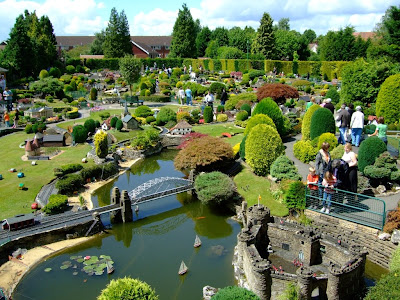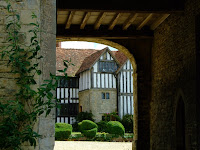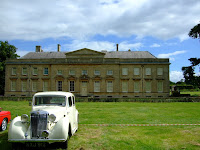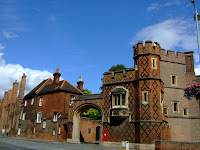There are a number of model villages in the UK and we have visited those at Godshill in the Isle of Wight, Bourton-on-the-Water and Wimborne Minister but it has taken us seven years to get around to visiting the largest, oldest and certainly our closest model village; the Beckonscot Model Village at Beaconsfield.

We must have driven past the sign at Exit 2 on the M40 hundreds of times in those seven years, often remarking that we must call in one day; but we were always rushing off to somewhere or on our way home late in the day, so never made it.
So today was the day, and well worth the detour it was too. Unlike the other villages, this one is very much alive with model trains, trams, sailboats, cable cars, merry-go-rounds, Ferris wheels, and even a house fire - all operating.

The other three are models of the town in which they are situated; and in each of them one can find the model of the model in the model. This one is not modelled on any real village; it just echoes many familiar English scenes. One “real” model is of a house that no longer exists, Green Hedges, the Beaconsfield home of Enid Blyton.

Originating as a back-yard hobby in the 1920s, the owner chose a scale of one inch to the foot (1:12) and this has become the standard scale for dolls’ houses to this day. Over the years the village changed with the times until the decision was taken in 1993 to restore the village to the idealised 1930s that its creator started with. There are a few cars scattered around that are a little later than the 30s but the overall effect is quite captivating.

It is riddled with merchant’s names to amuse, if you are fond of cringe-worthy puns. Argue & Twist, Solicitors; W.E. Humpit & U.Burnet, Coal Merchants; Juan Coat, Painter and Decorator; Chris P. Letis, Greengrocer and so on.

We stopped briefly in Princes Risborough where we bumped into the Street Parade and fancy dress that begins their annual town festival. Children from the various educational establishments, along with a few parents, were making their way down the main street.

Much, much less busy was the village of Long Crendon where, at the end of the very pretty High Street, one can find the Old Courthouse. Built in 1500 it is a beautiful old timber framed building that was saved from demolition in 1900 and placed in the care of the National Trust as one of the Trust’s first few properties.
 One of the current sources of civic pride is St Petersburg is the new ring road motorway around three sides of the city. We were proudly introduced to this as we rode it from the airport to the river port to embark on the MS Bunin. However, not to far along I noticed that all the vehicles in the right-hand lane were actually reversing against the flow of traffic. Just then the guide noticed and commented and then the driver decided that there was good reason for this strange behaviour (a traffic jam ahead) and decided to join the movement.
One of the current sources of civic pride is St Petersburg is the new ring road motorway around three sides of the city. We were proudly introduced to this as we rode it from the airport to the river port to embark on the MS Bunin. However, not to far along I noticed that all the vehicles in the right-hand lane were actually reversing against the flow of traffic. Just then the guide noticed and commented and then the driver decided that there was good reason for this strange behaviour (a traffic jam ahead) and decided to join the movement.  So, our first new experience in Russia was reversing along the motorway to the off-ramp we had just passed.
So, our first new experience in Russia was reversing along the motorway to the off-ramp we had just passed.



































